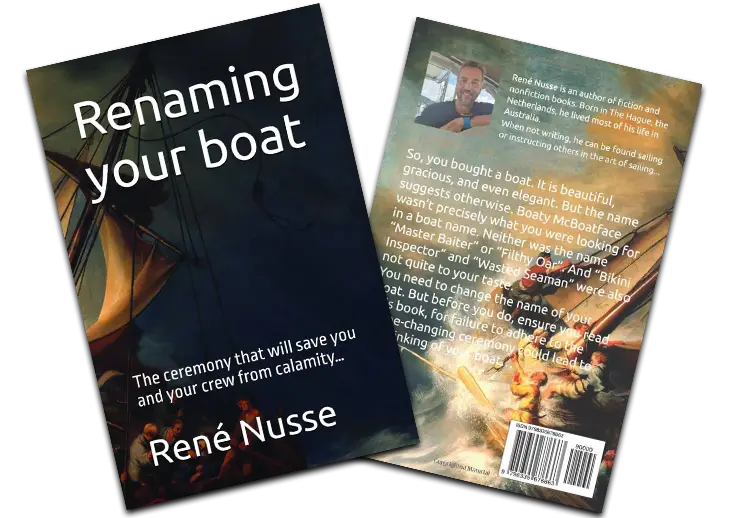Tell-Tales
Tell-tales are small pieces of yarn, ribbon, or other lightweight materials attached to the sails or rigging of a sailboat. They provide visual airflow indicators and help sailors trim their sails more effectively. Here’s how to use tell-tales for optimal sail performance:
1. Understanding Tell-Tales
Tell-tales help you see how the wind flows over the sail and provide feedback on sail trim and overall sailboat performance. By observing the tell-tales’ behaviour, you can adjust your sails to improve speed and balance.
2. Placement of Tell-Tales
- Sails: Tell-tales are typically placed on the leading edge of the sail (luff) and sometimes along the sail’s leech (back edge).
- Headsail (Jib/Genoa): Tell-tales are usually placed along the luff of the headsail, one near the top and one near the bottom. Additional tell-tales may be placed along the leech for fine-tuning.
- Mainsail: Tell-tales are often placed along the luff and the leech. They can also be placed on the batten pockets.
3. Using Tell-Tales
3.1. Headsail (Jib/Genoa)
Upwind Sailing (Beating):
- Proper Trim: When the sail is trimmed correctly, the tell-tales should flow smoothly from the luff to the leech. The top tell-tale should flow straight back or slightly windward, while the bottom tell-tale should flow more directly back.
- Flapping Tell-Tales: If the tell-tales on the luff are flapping, the sail is likely overtrimmed. Ease the sheet slightly until the tell-tales flow back smoothly.
- Stalled Tell-Tales: If the tell-tales on the luff are stalled or facing forward, the sail is likely under trimmed. Trim the sail until the tell-tales flow correctly.
Reaching: under-trimmed
- Proper Trim: On a reach, the tell-tales should flow evenly from the luff to the leech, with the top tell-tale flowing more parallel to the sail and the bottom tell-tale flowing slightly back.
- Adjustments: Adjust the sail trim to achieve a smooth tell-tale flow. This will ensure efficient airflow and optimal speed.
3.2. Mainsail
Upwind Sailing (Beating):
- Proper Trim: The tell-tales on the mainsail’s luff should flow straight back or slightly windward. The tell-tales on the leech should flow straight back, with a slight angle depending on sail shape and wind conditions.
- Flapping Tell-Tales: If the tell-tales on the luff are flapping or stalling, the sail may be overtrimmed. Ease the mainsheet or adjust the vang to improve airflow.
- Stalled Tell-Tales: The sail is under-trimmed if the tell-tales are stalled or facing forward. Trim the mainsheet or adjust the sail controls to correct this.
Reaching:
- Proper Trim: On a reach, the tell-tales should flow evenly from the luff to the leech, with the top tell-tale flowing more parallel to the sail and the bottom tell-tale flowing slightly back.
- Adjustments: Fine-tune the sail trim to ensure that the tell-tales provide a consistent flow of wind and avoid turbulence.
4. General Tips
- Watch the Tell-Tales Continuously: Regularly monitor the tell-tales during sailing to ensure optimal sail trim. Conditions can change, requiring adjustments.
- Avoid Over-Complicating: Tell-tales are valuable tools, but don’t overcomplicate adjustments. Make incremental changes and observe their effects.
- Practice Makes Perfect: Familiarize yourself with how tell-tales behave in different conditions. Practice will help you understand how to interpret their signals effectively.
5. Troubleshooting
- Uneven Flow: If tell-tales on one side of the sail behave differently than those on the other, there may be an issue with sail trim or the boat’s balance. Adjust the sails and check for rigging issues.
- Conflicting Signals: Sometimes, tell-tales might give conflicting signals due to turbulence or other factors. For a complete picture, use them with other indicators, such as boat speed and heel angle.
By effectively using tell-tales, you can fine-tune your sail trim, improve boat performance, and enjoy a more efficient and enjoyable sailing experience.
When the outside tell-tales are not flowing, let the sheet out.
When the inside tell-tales are not flowing, take the sheet in.

NAVIGATION RULES CLINIC + BASIC SAIL TRIM COURSE
Author
-

Rene is a keelboat instructor and sailing coach in the Mandurah area WA. He is also the author of several books about sailing including "The Book of Maritime Idioms" and "Renaming your boat".
View all posts


